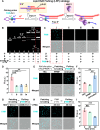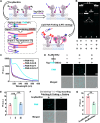A Patching and Coding Lipid Raft-Localized Universal Imaging Platform
- PMID: 39474480
- PMCID: PMC11503886
- DOI: 10.1021/cbmi.3c00109
A Patching and Coding Lipid Raft-Localized Universal Imaging Platform
Abstract
Lipid rafts (LRs) are relatively well-ordered functional microdomains in cell membranes and play an irreplaceable role in physiological processes as a transduction platform for multiple signaling pathways. Due to their small size and high spatiotemporal dynamics, it is difficult to perform lipid raft-localized biomolecule imaging on the surface of living cells. Here, we report a DNA nanotechnology-based platform for reversible manipulation and localized analysis of lipid rafts, which consists of two modules: "patching and coding probe pair" and "fishing probe". The probe pair is generated by modifying two different sets of connectable DNA structures on a lipid raft-specific protein. After recognizing lipid rafts, the two probes in close proximity are linked by a DNA ligase reaction to form a lipid raft identity (LR-ID) code. The LR-ID strand patches and stabilizes the lipid raft structure. Interestingly, the raft patches formed can be depatched by restriction endonucleases, providing the first reversible manipulation of the lipid raft structure in living cells. We also designed a "fishing probe" with a DNA hairpin structure using an aptamer that can specifically bind to the target. The probe can cascade the reaction to two input signals "LR-ID" and "target protein" to generate an "off-on" fluorescence switch, allowing imaging and dynamic monitoring of target proteins localized in lipid rafts. By encoding arbitrary targets (in the case of glycans) in lipid rafts, we have created a universal lipid raft-localized imaging platform. This work provides an integrated analytical and manipulative platform to reveal lipid rafts and associated signaling pathways at the molecular level.
© 2023 The Authors. Co-published by Nanjing University and American Chemical Society.
Conflict of interest statement
The authors declare no competing financial interest.
Figures






Similar articles
-
Hierarchical Fluorescence Imaging Strategy for Assessment of the Sialylation Level of Lipid Rafts on the Cell Membrane.Anal Chem. 2021 Nov 9;93(44):14643-14650. doi: 10.1021/acs.analchem.1c02738. Epub 2021 Oct 26. Anal Chem. 2021. PMID: 34698497
-
Determination of lipid raft partitioning of fluorescently-tagged probes in living cells by Fluorescence Correlation Spectroscopy (FCS).J Vis Exp. 2012 Apr 6;(62):e3513. doi: 10.3791/3513. J Vis Exp. 2012. PMID: 22508446 Free PMC article.
-
Some new faces of membrane microdomains: a complex confocal fluorescence, differential polarization, and FCS imaging study on live immune cells.Cytometry A. 2008 Mar;73(3):220-9. doi: 10.1002/cyto.a.20516. Cytometry A. 2008. PMID: 18163467
-
Lipid rafts: cell surface platforms for T cell signaling.Biol Res. 2002;35(2):127-31. doi: 10.4067/s0716-97602002000200003. Biol Res. 2002. PMID: 12415729 Review.
-
Sphingomyelin and cholesterol: from membrane biophysics and rafts to potential medical applications.Subcell Biochem. 2004;37:167-215. doi: 10.1007/978-1-4757-5806-1_5. Subcell Biochem. 2004. PMID: 15376621 Review.
Cited by
-
The significance of calcium ions in cerebral ischemia-reperfusion injury: mechanisms and intervention strategies.Front Mol Biosci. 2025 May 12;12:1585758. doi: 10.3389/fmolb.2025.1585758. eCollection 2025. Front Mol Biosci. 2025. PMID: 40421420 Free PMC article. Review.
-
Proximity-activated DNA scanning encoded sequencing for massive access to membrane proteins nanoscale organization.Proc Natl Acad Sci U S A. 2025 Apr 15;122(15):e2425000122. doi: 10.1073/pnas.2425000122. Epub 2025 Apr 10. Proc Natl Acad Sci U S A. 2025. PMID: 40208941
References
LinkOut - more resources
Full Text Sources
